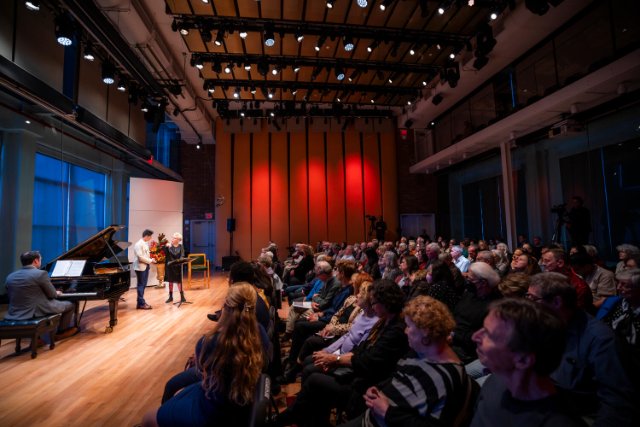Joyce Di Donato Teaches at Carnegie Hall
Master Classes for Artists and Listeners Too
By: Susan Hall - Oct 26, 2023
Joyce Di Donato arrived at Carnegie Hall after her highly successful run at the Metropolitan Opera in Jake Heggie’s Dead Man Walking. At Carnegie she spoke about headlining a production of the opera at City Opera two decades ago under the direction of Leonard Foglia. Her overarching theme at Carnegie was the notion that we should dwell in our joy and not let anyone breach that feeling. It is perhaps not curious that she spoke about City Opera and avoided the Met experience. Even for the newspaper of record, which has shilled for the Met Opera for decades, the current production was more like “Dead Met Walking.”
DiDonato advocates the presence of being. To each of the four young artists she worked with for three days in Carnegie’s Resnick Education Wing, she brought her consummate knowledge of the voice and her thoroughly engaged ear.
No one is left out. She honored the accompanying pianists Joel Harder and Justina Lee for their completely present support of the young artists and their teacher.
Trayvon D. Walker of the Lyric Opera’s Ryan Center, offered the most adventuresome repertoire. In addition to Igor Stravinsky’s Tom from The Rake’s Progress, he sang Lonely House from Street Scene. You could hear his wonderfully deep interpretation of the text lodged in his voice which is caught in some magical place between speech and song for the Kurt Weill music. For Di Donato, everything begins with the word, so she delved deep into the interpretation of Langston Hughes’ lyrics.
Augustin Pennino from Uruguay has a countertenor voice from heaven. It is pure joy to listen to him. Handel can do no wrong for Di Donato, and the purity of Pennino’s voice seems just right for the composer. Yet, to provide interest and pleasure, Di Donato suggests digging in, giving shape to phrases and texture to the lovely notes. Pennino works at this successfully.
Di Donato keeps mentioning her own age in relation to these artists who are in their twenties, three decades younger than she is. In her presence, and when we see her on stage, age is not something that occurs to us–she is so fresh and energetic. She is perhaps asking us to understand an artist like Jazmine Saunders, who comes to Carnegie via the Eastman School of Music and Juilliard. She has a glorious instrument that is in process. Process interests Di Donato even more than the outcome. Saunders sings one of Donna Anna’s arias from Don Giovanni and Di Donato then leads her through its emotional arc.
Process may also be what attracts the listener to music. We can see how emotional beauty is created. Karen Mathilde Heoer Hovd from Norway has already arrived. (Of course, tweaking goes on forever.) And whether or not we can identify what it is about this voice and presentation that is so compelling, everyone recognizes it–the audience and the teacher. Di Donato does not want to disturb what she hears in this performance.
In the final session, Di Donato discusses something she learned during that long-ago City Opera performance of Dead Man Walking. You have to leave space for the listeners to enter the music. This space is created by not answering all the questions the listening ear may have. That is something for all of us to think about – particularly people committed to the long-range success of classical music. Joyce Di Donato has left us with an empty space to fill, after filling six hours with the pure joy of learning.

